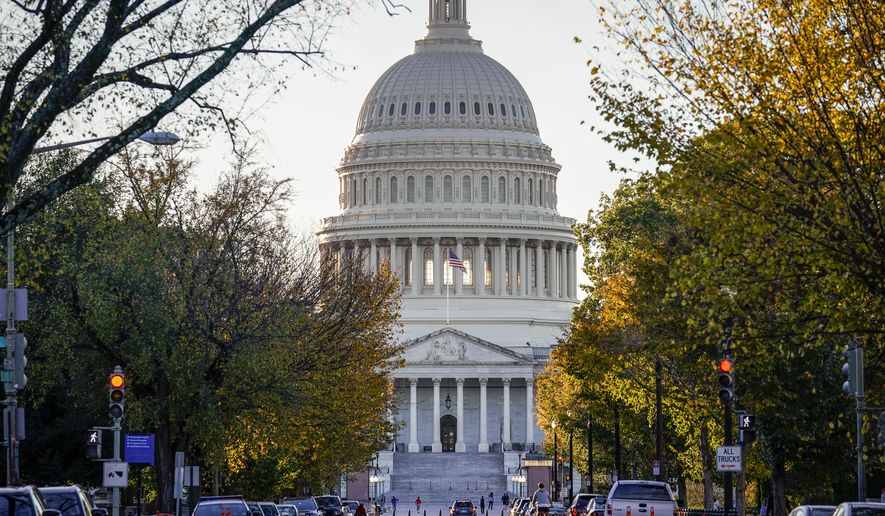The Democrats’ enormous cash advantage in the 2020 elections failed to translate into equally massive House and Senate wins as the financially outgunned Republicans delivered more bang for their political buck.
Republican House and Senate candidates outperformed expectations despite a significant fundraising deficit, spending $3.8 billion versus $6.9 billion for the Democrats, according to an Oct. 28 analysis by the Center for Responsive Politics.
House Republicans picked up at least six seats — with more expected as uncalled races are decided — while Senate Republicans were poised to retain their majority as most incumbents hung onto their seats in the face of a fierce Democratic financial headwind.
“It is amazing that with the leadership of almost every major institution in America arrayed against conservatives that Republicans were basically able to battle establishment Democrats to a tie,” said Richard Viguerie, political direct-mail pioneer and founder of ConservativeHQ, on a call with reporters.
“The massive establishment forces against the president and the GOP including entertainment, Hollywood, the mainstream media, Big Tech billionaires and their companies, academia and unions,” Mr. Viguerie said. “Liberals raised at least 500% more money from 500% more donors in the last two years than conservatives and Republicans did.”
Former Vice President Joseph R. Biden, who was ahead of President Trump on Thursday in the electoral vote count, also outraised the Trump campaign on his way to becoming the second $1 billion candidate in history, after Michael R. Bloomberg, who spent 10 figures in the 2020 Democratic primary.
The Democrats’ fundraising supremacy, fueled by megadonors such as Mr. Bloomberg, Tom Steyer and George Soros as well as Hollywood, Silicon Valley and Wall Street giving, is starting to look more like a feature of political campaigns than a blip.
“Driven by their supporters’ strong opposition to Trump, Democrats are continuing their fundraising prowess that helped them dominate the money race in the 2018 election cycle,” said the Center for Responsive Politics. “Their money machine is more powerful than ever in 2020.”
There were several explanations in play as to why Democratic money failed to produce equally big wins.
For one, Democrats threw hundreds of millions of dollars into long-shot Senate races in red states against entrenched incumbents, including Republican Sens. Lindsey Graham in South Carolina and Mitch McConnell in Kentucky.
“Increasingly, when Dem donors see a shiny object in a red/purple state, they flood the zone w/ out-of-state $$. And in combing through Tuesday’s down-ballot wreckage, it’s not clear that $$ did more good than harm,” tweeted David Wasserman, House editor of the Cook Political Report.
A record $8.15 billion was spent on 2020 campaign advertising, with $4.6 billion for Democratic candidates, parties and political-action committees versus $2.6 billion for Republicans. Another $907 million was spent by independents, according to Advertising Analytics.
That spending had Democrats predicting another blue wave that would result in additional House seats and a Senate takeover, but as of Thursday, it appeared that Republicans had locked up at least 48 seats and would keep their majority.
In addition, Republicans led in the uncalled races in Alaska and North Carolina. Runoff elections for the two Georgia Senate seats will be held Jan. 5.
The meager Democratic showing came in spite of some lopsided spending. In North Carolina, Democratic Senate challenger Cal Cunningham raised $47 million as of Oct. 14 versus $21 million for Republican Sen. Thom Tillis, according to the center.
In Iowa, Democrat Theresa Greenfield raised $47 million to GOP Sen. Joni Ernst’s $23.5 million. In Kentucky, Mr. McConnell raised $55.5 million to Democrat Amy McGrath’s $88 million.
It wasn’t enough. Mr. McConnell coasted to victory by a margin of 58% to 38%, while Ms. Ernst won by 52% to 45%. The North Carolina race has not been called, but Mr. Tillis holds a 48.7% to 46.9% lead with 94% of the vote counted.
In South Carolina, Mr. Graham won by 10 percentage points despite being heavily outraised by Democratic challenger Jaime Harrison, who amassed a mind-boggling $107.6 million versus $72.7 million for Mr. Graham.
“There is a law of diminishing returns based on a couple of things,” said Floyd Ciruli, director of the Crossley Center for Public Opinion Research at the University of Denver. “One is that the number of voters who are actually persuadable toward the end gets smaller and smaller, so you’re spending this immense amount of money on television or digital advertising for just a tiny electorate.”
In addition, there are only so many places to spend that cash, given that television and radio advertising space is finite.
“In some states, you can’t buy that much television,” Mr. Ciruli said. “I mean, what do you do with $100 million in South Carolina? You could buy the station.”
Democratic fundraising soared after the Sept. 18 death of Justice Ruth Bader Ginsburg, a relatively late infusion of cash that encouraged advertising to the point of overkill.
“The other thing that happens is that the public simply gets not only immune to it, they get disgusted,” Mr. Ciruli said. “At a certain point the nonstop advertising becomes too much, and that was a frequent comment the last week or so in South Carolina.”
Conservatives offered another explanation: They had the better message.
“The best way to kill a bad product is to advertise it heavily,” said Americans for Tax Reform President Grover Norquist. “If you spend the money selling higher energy prices, and less production of energy, and higher taxes, that won’t do well.”
• Valerie Richardson can be reached at vrichardson@washingtontimes.com.




Please read our comment policy before commenting.